Figures & data
Figure 1. Calculated allowable power deposition for a simulated cylinder of muscle tissue based on limits proposed by Atkinson et al. Citation[25], with (A) varying frequency (f) and field amplitude (H) for cylinder having a radius, r = 0.15 m, and (B) varying field amplitude (H) and radius (r) of simulated tissue at a fixed frequency of 160 kHz. Blue zones display combinations that do not exceed maximum allowable limits, whereas red zones represent fields and exposures that exceed tolerance limits.
![Figure 1. Calculated allowable power deposition for a simulated cylinder of muscle tissue based on limits proposed by Atkinson et al. Citation[25], with (A) varying frequency (f) and field amplitude (H) for cylinder having a radius, r = 0.15 m, and (B) varying field amplitude (H) and radius (r) of simulated tissue at a fixed frequency of 160 kHz. Blue zones display combinations that do not exceed maximum allowable limits, whereas red zones represent fields and exposures that exceed tolerance limits.](/cms/asset/32e57ba3-1b44-42a2-82d1-dcad87d660bf/ihyt_a_764023_f0001_b.gif)
Figure 2. (A) Circuit diagram of the AMF system. (B) The four turn solenoid coil modelled using MoM. The coil inner diameter is 45 mm and coil length is 32 mm.

Figure 3. Picture of the 4-turn solenoid coil, water jacket and mouse chamber with anaesthetised mouse inside.
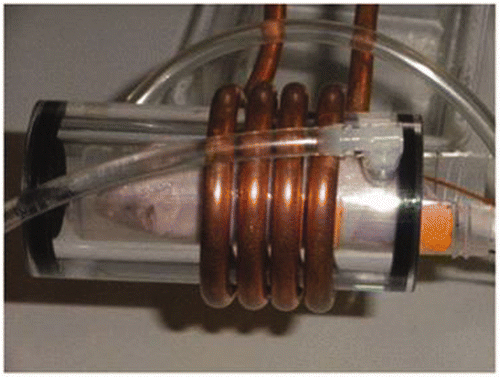
Table I. Physical parameters and data used for thermal simulations.
Table II. AMF coil electrical properties.
Table III. AMF coil voltage, V and magnetic field, kA/m.
Figure 4. Magnetic field across the (x–z plane) in the coil in the sample volume with no water (A) and with water (B) in the jacket; Magnetic field profile along the middle of solenoid in z direction without water (C) and with water (D) for 8 kW (peak) input power to AMF coil.
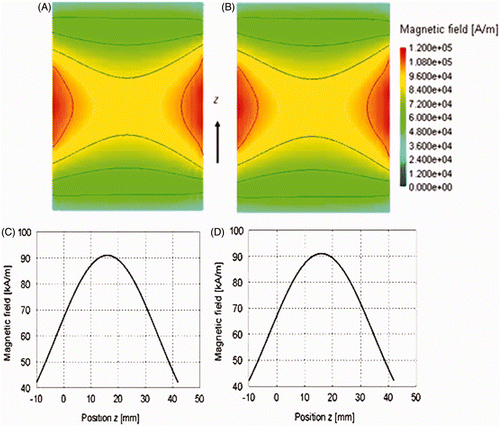
Table IV. Comparison of experimentally measured magnetic field (kA/m) with and without water jacket.
Figure 5. Temperature profile at the end of 1200 s of AMF exposure. (A) No external cooling. (B) Dual chamber discontinuous cooling at 35°C. (C) Dual chamber discontinuous cooling at 27°C. (D) Single chamber continuous cooling at 35°C. (E) Comparison of maximum and minimum temperatures in the domain among cases B, C and D.
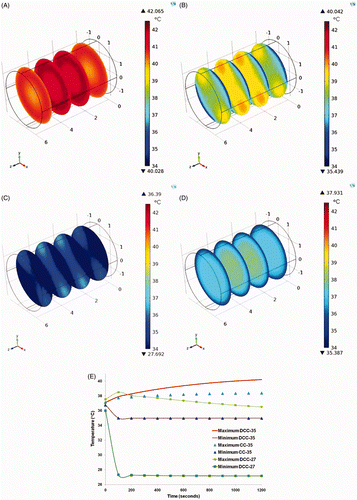
Table V. Gel phantom temperature data.
Figure 6. Comparison of net initial rate of temperature change in the gels for conditions I, II, and III.

Figure 7. Observed temporal change in temperatures of (A) individual mice at each of the three conditions (I, II, and III) with no AMF, and (B) with 20 min exposures to AMF having amplitude of 84 kA/m. Displayed are corrected (T(t)–T(0)) data obtained from each of four temperature probes (two placed s.c. in left and right thorax, one affixed to skin surface of abdomen, and one inserted into rectum.
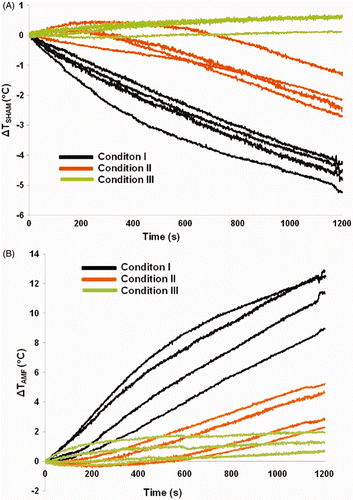
Figure 8. Corrected temperature change as measured in the thorax (A) and rectum (B) for mouse exposed to AMF with no water, i.e. condition I (solid line), mouse exposed to AMF with water but no active cooling, i.e. condition II (dashed line), and mouse exposed to AMF with actively cooled water, i.e. condition III (dash-dot-dot). Subcutaneous thoracic temperatures were averaged for both left and right side. In all cases the temperature change for each temperature probe was calculated from measured temperatures and the total change of temperature was estimated after subtracting temperature changes obtained from sham controls.
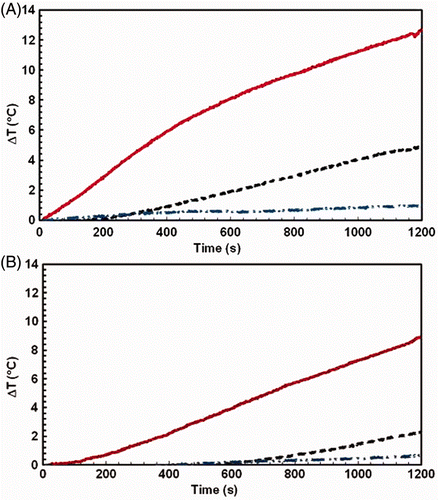
Table VI. Mouse temperature data.